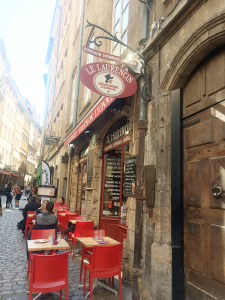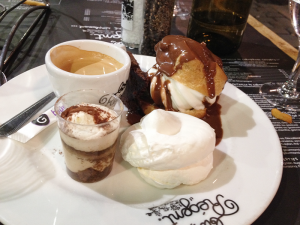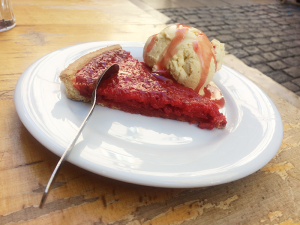Silk Workers’ Brains and Other Culinary Delights
Enjoying the food in the city of Lyon, France’s gastronomic capital
By Michele Reed
michele@cny55.com
Photos by Bill Reed

Bill and I ate silk workers’ brains and they were delicious! Don’t worry, we’re not zombies. We were enjoying cervelle de canut, one of the culinary delights of the city of Lyon, France’s gastronomic capital.
Situated between the butter-loving regions of Alsace and Lorraine to the north and the vegetable and olive oil-based cuisines of Provence and the Mediterranean, Lyon melded the two to create its own rich heritage of French cookery.
Silk workers’ brains, despite its gruesome name, is actually a simple and delightful treat: soft white cheese mixed with white wine, a little milk and herbs. Think sour cream and chive dip with a French accent. It’s served in a little bowl and you dip small pieces of crusty baguette to scoop out bite-sized portions of the “brains.” The name refers to Lyons’ major industry until the 1930s, silk making. At its height, the silk trade employed more than 90,000 workers and they needed a simple, portable lunch to take with them.
In addition to the brains, Bill and I tasted other staples of the silk workers’ lunch pail, a ham-salad-like concoction of tripe in a sauce like vinegary mayonnaise with bits of pickle (we didn’t love it), and rosette de Lyon, a spicy, cured sausage made of leg of pork, and Lyon’s most famous sausage (we did love it).
We topped it all off with tarte praline, but this is not your grandmother’s praline pie, that gooey Thanksgiving staple full of pecans and brown sugar. When the server brought it to our table, I did a double take. This pie was pink — bright pink. Fuchsia. I called back the waitress and asked what was in it. “Pralines,” she answered a little slowly and emphasizing each syllable, as one would to a very small child. “What makes it pink?” I pressed on. “Is it raspberry?” She gave a Gallic shrug. “Pralines,” she repeated, apologizing for her lack of English to explain. It tasted delicious, so I finished every morsel, and looked up the recipe on the internet when I returned home. Pralines, the signature candy of Lyon, are almonds coated in multiple layers of pink sugary syrup. They are a traditional treat on their own, but for the pie, they are ground up and boiled with cream to make the pie filling.

The most famous type of restaurant in Lyon are the bouchons, tiny, family-run restaurants noted for serving traditional Lyonnaise cuisine and having a friendly, lively atmosphere. Lucky for us, our hotel was three blocks away from a hotbed of bouchon culture, the rue des Marronniers, or Chestnut Tree Street. There we had our first meal in Lyon, a three-course lunch, enjoyed in the company of a Swiss lady who invited us to share her table. She had been traveling by train between Italy and her home in Geneva, and took advantage of a layover for lunch at this particular restaurant, which she had been visiting for 40-plus years. The entrée, or first course, was gateau foie de vollaille, chicken livers baked into a tiny, cushiony cake and swimming in a savory tomato sauce. The main course was tender baked fish in a butter herb sauce with piped mashed potatoes and a fluffy egg dish made with zucchini. Dessert was soft white cheeses enjoyed with baguette. We savored the meal with a pot Lyonnaise or half-bottle of rosé wine.
The pot Lyonnaise is another invention that harkens back to the silk trade. The bosses were required by law to provide 50 cl, or a half-liter of wine per worker each day. They created a bottle with a very thick glass base, which results in a serving of only 46 cl. This way, the boss could take a liter of wine and fill two pots and have a glass left over for himself. All this bounty, three-course meal for two with wine, cost only 37 euros or about $42.
It’s not all silk worker’s brains and bouchons in Lyon. The city didn’t earn the title of gastronomic capital of France only for its simple, rustic fare. The city was the birthplace of chef Paul Bocuse, one of Lyon’s most famous sons. The three-star Michelin chef was one of the pioneers of nouvelle cuisine, a modern, lighter version of French cookery. According to legend, it debuted when Bocuse and two other chefs created the menu for the maiden voyage of the Concorde in 1969. When he died in January of 2018 at the age of 91, all of France mourned and hundreds of chefs in their white coats attended his funeral in Lyon’s cathedral.

The chef founded the Institut Paul Bocuse in Lyon, which teaches culinary arts and hotel management to students from all over the world. The institute restaurant was a couple of blocks from our hotel, so we peeked in, considering dinner on our last night in the city. With its contemporary décor designed by Pierre-Yves Rochon, it looked as elegant as the dishes being prepared by the student chefs. But with three-course dinners running at the equivalent of $60 per person, we decided to save the experience for a future visit.
With a newfound taste for silk workers’ brains and the other culinary masterpieces of Lyon, we knew we’d be back someday.

